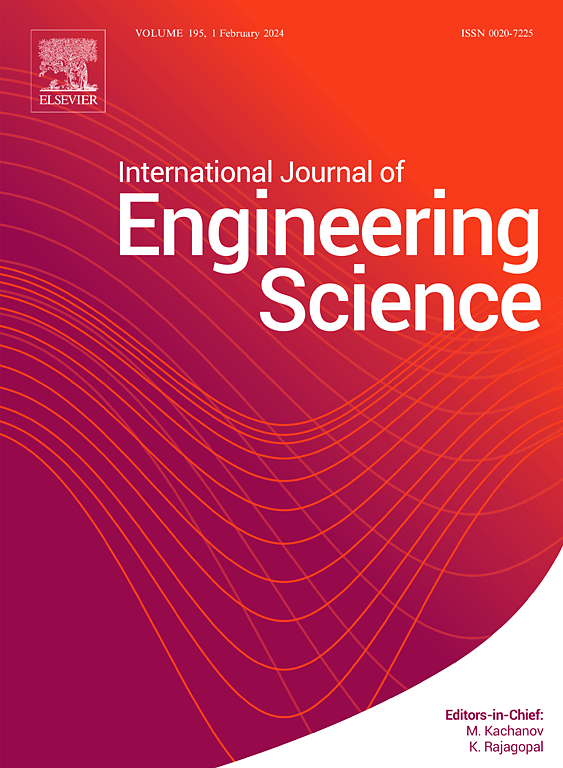功能梯度介电弹性体的不等双轴拉伸状态
IF 5.7
1区 工程技术
Q1 ENGINEERING, MULTIDISCIPLINARY
International Journal of Engineering Science
Pub Date : 2025-05-14
DOI:10.1016/j.ijengsci.2025.104291
引用次数: 0
摘要
具有厚度梯度的薄介电弹性(DE)板在外加电压下变形和起皱。这种褶皱在薄的功能梯度DEs中具有规则的周期性模式,通过面外变形使面内压应力松弛。这些功能分级的基于de的软执行器,主要用于软机器人应用,与非分级的软执行器相比,表现出高度局部化的点负载。基于de的软执行器经常表现出各种不稳定性,这可能对其功能产生不利影响并引发设备故障。相反,微调皱纹可以在特定应用中主动利用,需要有意向的方向梯度转换和双轴变形的截断。本文提出了一个实验验证的连续介质物理模型,该模型结合经典张力场理论来预测主拉伸平面内张力域的阈值。该模型解提供了受梯度参数和双轴比影响的紧绷域偏差在该材料类别的皱纹形成的非等双轴变形中的洞察。本文章由计算机程序翻译,如有差异,请以英文原文为准。
Unequal-biaxial taut states of functionally graded dielectric elastomers
A thin dielectric elastomeric (DE) plate with thickness gradients deforms and wrinkles under applied voltages. Such wrinkling, with regular periodic patterns in thin functionally graded DEs, occurs to relax in-plane compressive stresses through out-of-plane deformations. These functionally graded DE-based soft actuators, primarily used in soft robotic applications, exhibit highly localized point loads compared to non-graded soft actuators. DE-based soft actuators frequently exhibit a variety of instabilities, which may adversely affect their functioning and trigger device failure. Conversely, fine-tuned wrinkles can be utilized proactively in specific applications, necessitating an intentional transformation with directional gradients and the truncation of biaxial deformations. This paper presents an experimentally verified continuum physics-based model under a special case for unequal-biaxial deformation in functionally graded DEs. The proposed model integrates classical tension field theory to predict thresholds in taut domains within the plane of principal stretches. The model solutions provide insight into the deviations of taut domains influenced by the graded parameter and the biaxiality ratio in unequal-biaxial deformations of wrinkle formations in this material class.
求助全文
通过发布文献求助,成功后即可免费获取论文全文。
去求助
来源期刊

International Journal of Engineering Science
工程技术-工程:综合
CiteScore
11.80
自引率
16.70%
发文量
86
审稿时长
45 days
期刊介绍:
The International Journal of Engineering Science is not limited to a specific aspect of science and engineering but is instead devoted to a wide range of subfields in the engineering sciences. While it encourages a broad spectrum of contribution in the engineering sciences, its core interest lies in issues concerning material modeling and response. Articles of interdisciplinary nature are particularly welcome.
The primary goal of the new editors is to maintain high quality of publications. There will be a commitment to expediting the time taken for the publication of the papers. The articles that are sent for reviews will have names of the authors deleted with a view towards enhancing the objectivity and fairness of the review process.
Articles that are devoted to the purely mathematical aspects without a discussion of the physical implications of the results or the consideration of specific examples are discouraged. Articles concerning material science should not be limited merely to a description and recording of observations but should contain theoretical or quantitative discussion of the results.
 求助内容:
求助内容: 应助结果提醒方式:
应助结果提醒方式:


